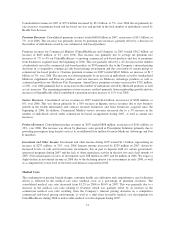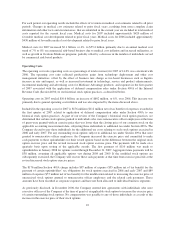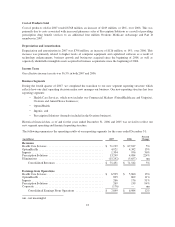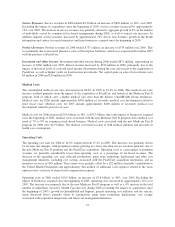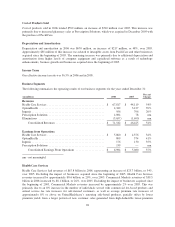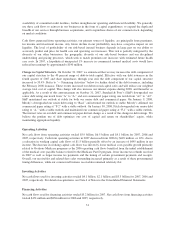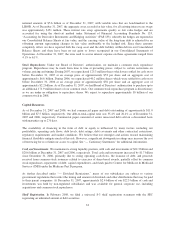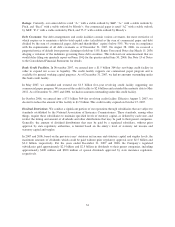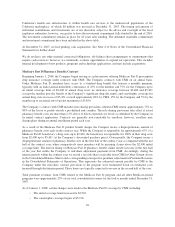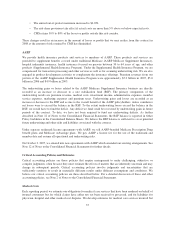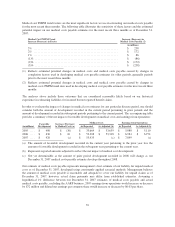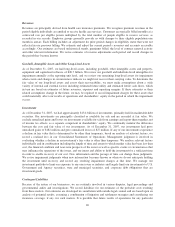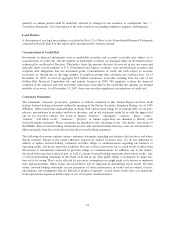United Healthcare 2007 Annual Report Download - page 33
Download and view the complete annual report
Please find page 33 of the 2007 United Healthcare annual report below. You can navigate through the pages in the report by either clicking on the pages listed below, or by using the keyword search tool below to find specific information within the annual report.availability of committed credit facilities, further strengthen our operating and financial flexibility. We generally
use these cash flows to reinvest in our businesses in the form of capital expenditures, to expand the depth and
breadth of our services through business acquisitions, and to repurchase shares of our common stock, depending
on market conditions.
Cash flows generated from operating activities, our primary source of liquidity, are principally from premiums,
fee income and investment income. Any future decline in our profitability may have a negative impact on our
liquidity. The level of profitability of our risk-based insured business depends in large part on our ability to
accurately predict and price for health care and operating cost increases. This risk is partially mitigated by the
diversity of our other businesses, the geographic diversity of our risk-based business and our disciplined
underwriting and pricing processes, which seek to match premium rate increases with estimated future health
care costs. In 2007, a hypothetical unexpected 1% increase in commercial insured medical costs would have
reduced net earnings by approximately $190 million.
Change in Capital Structure. On October 31, 2007, we announced that we may increase the debt component of
our capital structure to the 40 percent range of debt-to-total-capital. Effective with our debt issuances in the
fourth quarter of 2007 and share repurchases through year end, the debt component of our capital structure
increased to 35.4%. Refer to “—Financing Activities” below for further detail of the debt issuances, including
the February 2008 issuance. These events increased our debt-to-total-capital ratio and will reduce our weighted
average total cost of capital. This change will also increase our interest expense during 2008, and thereafter as
applicable. As a result of this announcement on October 31, 2007, Standard & Poor’s (S&P) downgraded our
senior debt rating one notch from “A” to “A-” and our commercial paper rating one notch from “A1” to “A2”.
S&P maintained our outlook at stable for both our senior debt and commercial paper. On January 9, 2008,
Moody’s downgraded our senior debt rating to “Baa1” and returned our outlook to stable. Moody’s affirmed our
commercial paper rating at “P-2” with a stable outlook. On January 30, 2008, Fitch downgraded our senior debt
rating to “A-” with a stable outlook and maintained our commercial paper rating at “F-1” with a stable outlook.
The interest rates on our debt and commercial paper did not change as a result of the change in debt ratings. We
believe the prudent use of debt optimizes our cost of capital and return on shareholders’ equity, while
maintaining appropriate liquidity.
Operating Activities
Net cash flows from operating activities totaled $5.9 billion, $6.5 billion and $4.1 billion for 2007, 2006 and
2005, respectively. Cash from operating activities in 2007 decreased from 2006 by $649 million, or 10%, due to
a reduction in working capital cash flows of $1.5 billion partially offset by an increase of $495 million in net
income. The decrease in working capital cash flows was driven by lower medical costs payable growth primarily
related to Ovations Medicare programs as the 2006 operating cash flows benefited from the initial establishment
of the medical costs payable balance related to the Medicare Part D program, fewer income tax refunds received
in 2007 as well as larger income tax payments and the timing of certain government payments and receipts.
Overall, our receivables and related days sales outstanding increased primarily as a result of these governmental
timing differences, while our commercial business receivables remained relatively flat.
Investing Activities
Net cash flows used for investing activities totaled $4.1 billion, $2.1 billion and $3.5 billion for 2007, 2006 and
2005, respectively. For detail on acquisitions, see Note 4 of Notes to the Consolidated Financial Statements.
Financing Activities
Net cash flows used for financing activities totaled $3.2 billion for 2007. Net cash flows from financing activities
totaled $474 million and $836 million for 2006 and 2005, respectively.
31


